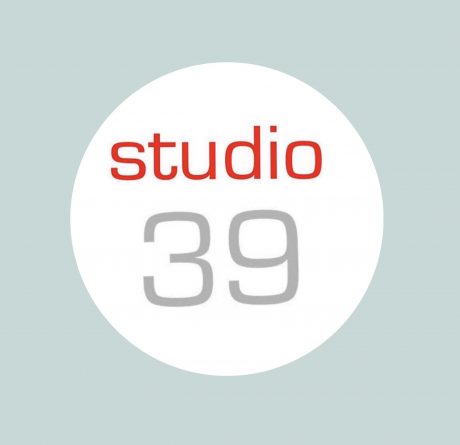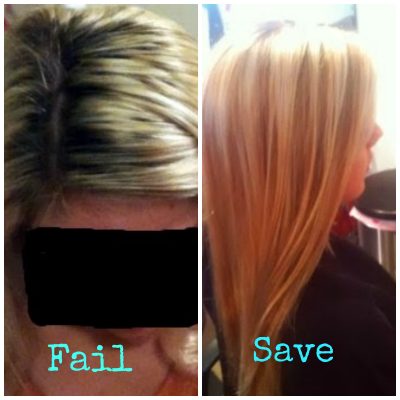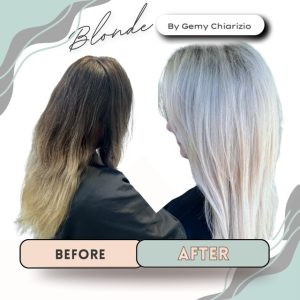The below post is linked on our Blonde page but was written in 2010 when the ombre trend was new. Ombre & balayage later peaked around 2015 and we spent a lot of time in the salon explaining that balayage is a technique and ombre is a look, 2 very different things!
When this was written in 2010 Pinterest was new and Instagram was not around yet! I was unaware of industry changes social media would bring. Fake news and false information were unimaginable. You can see glimpses of it beginning here as I sort out the shift I saw in our industry. Balayage is common now, but we still fix it often.
This post has over 7000 internal comments and over 900k views and is still linked by external sites 12 years later. I’d forgotten about it until a blogger recently asked to reference it and noticed my prediction about the corrective color market exploding had proved true, making this post more relevant today.
12 years later, social media made society & the beauty industry totally different, in good & bad ways. A post Covid era brought a new set of challenges. Inflation, supply shortages, and an exodus from the work force has caused a sharp decrease in service business. Especially salons. Yet demand is higher than ever so once again we see an increase of stylists doing services they’re not trained to do.
Being selective where to do business is more important than ever.
2010 Original Post
Hi readers! I recently learned my blog is kind of popular (blush), so people must want information from a salon insider. I get that. Part of my job when a client comes in is to inform them about the industry. Blogging is a way to get info out on specific topics. I also learned stylists are reading too. Thank you! Please know none of this is meant to offend! I write with clients in mind and my clients know I keep it real!
Ombre and Balayage 101
Today’s topic is ombre and balayage, sometimes referred to as Biolage, but that’s a shampoo brand-not a highlight technique! It’s ok, we hear lots of different terms for it! It’s newer to KC but it’s actually been around for a very long time. Alas, trends move slowly to the Midwest from the East and West Coast.
If I were a client seeking color, I would think most salons do hair color equally. Nope. With ombre and balayage there is a whole new area of color work evolving- SPECIALTY WORK. Balayage is unique so it falls under a “specialty” service. In the last 2 years we’ve seen a spike in 3 things.
- Clients requesting master stylists.
- Clients needing serious color fixes from severely botched color.
- Clients requesting master stylists to fix botched color from another “master” stylist.
Botched color in a “Master Stylist” boom?
Getting requests for “master” stylists is not new, but what’s up with all the bad color? Ombre and balayage confusion! That’s what’s going on.
We’re in a botched hair color boom, at least according to the horrifying color I’ve seen lately. There’s also a “master stylist” boom as well because the term is used to ride the ombre and balayage trend. As a result, stylist levels have become more misleading and confusing.
Ombre isn’t the only 2010 salon trend: too much ego and twice the gimmicks are taking our industry in the wrong direction. If younger stylists are unsure what a master stylist is, how will they know what to strive for? They wont but unfortunately it’s a problem created by our own industry. After beauty school, there’s no standard of skill set in our industry so terms like “master stylist” mean something different in every salon.
Salons are either doing things they think they can do and lack of education, or they’re misleading folks. Maybe a some of both, but most stylists want to please people, so some of this “failure to communicate” skill is perhaps somewhat unintentional. But the internet is ego driven, and that’s where people are finding ombre and balayage hair pictures, and a whole new crop of “master” stylists came with it.
Titles are earned.
I’ve been doing both ombre and balayage successfully for a while, but I also had the humbling experience of opening my salon at the age of 24. Even with my core cut training, I quickly realized there was much to learn in general- but especially with color. I never thought to call myself “master” until I earned it, but I was mentored by a real deal famous master stylist who charged $300 for a haircut in 1997. He was mentored by the original salon master, Vidal Sassoon so my scope of “master stylist” is different than most.
I asked once why it took so long to become a master stylist and he said “skill is passed down by teaching it through a process. The one receiving the training only becomes a master by maintaining the integrity of the process.” At age 21, that was seemed Jedi level deep and it took opening my own salon to understand he meant “great ones” don’t cut corners.
So, if a stylist wasn’t mentored by a true master stylist, or the one appointing the title is not one either, master title of skill shouldn’t be used! If background and training don’t back it up, over using “master” and “specialist” will soon make those terms mean nothing. Especially if it’s self-given. Logically if a stylist says they’re a ombre and balayage “specialist” then their ombre and balayage should be “special”. Not something I have to fix.
I’ve heard “I asked for an experienced stylist” during dozens of color corrections.
Years behind a chair does not equal experience in specialized skills.
Fixing a balayage “specialist’s” balayage⁉ 🤔
Below is an example of what I see regularly now. It tells me balayage and ombre are crashing into each other. This client didn’t want ombre, she wanted the soft grow out of traditional balayage. This is what she got. She called us frantic the next day to fix it. I was booked but couldn’t say no. What’s disturbing is I’ve had 5 new non referral balayage clients that have called recently equally distraught and was stunned when 4 clients said they saw “ombre or balayage specialists”.
Wait. What? Balayage specialist here…? In Kansas City…?
Well that’s weird. I started doing balayage in 2003. To. This. Day. 7 years later most people have no clue what it is until I tell them, including stylists! And I’ve made it my business (literally) to know who does what in KC, and who does it well. And most importantly – who is doing what I do. There’s a suspicious amount of color experts which is odd. Before this trend elite salons were already becoming a thing of the past. KC never had an abundance elite salons anyways because it’s more of an East coast thing, but we had some. If a stylist started out there, their bio would say so. The salon where I began my career was one of the last before they closed in KC, and I know who worked there.
My guess is the “master/specialist” stylists whose work I’m fixing have never been in an elite salon. Not trying to be jerky but that is where “master stylists & color specialists” come from. Fact. Or at least that’s where the term comes from. Most elite salons are divided into cut and color departments where you have to “earn” your chair. Master stylists were hair cutters and color specialists did color, but many stylists are using these titles without knowing that- I think?
“Master stylist or color specialist” sounds good though.
Research Carefully
Naturally when I see one of these hair autopsies, I google the salon or stylist and see a lot of “expert skill” advertised that doesn’t reflect the bleach skid marks I’m seeing on the hair of the crying client in my chair. All stylists have an off day once on awhile, but I don’t’ think this many stylists lives went sideways at once.
Something else is going on. This much bad color with more impressive sounding titles is alarming. Some titles I’ve never heard of and sound made up, but some salons are hurting from last year’s stock market crash. So the ombre trend has stylists scrambling to learn balayage to do it.
Ironically, the bad economy is what sparked the ombre trend. People couldn’t afford to get highlights, so they grew them out. Add Prada’s popular ombre collection last year- boom, ombre color is 2010’s version of the Friends shag haircut in 1996. But when I see a whack color job from a “balayage specialist” HERE in KC, it’s time to say whoa. Let’s back it up, calm it down & talk facts.
Balayage takes years to develop and it’s French in origin, so many stylists haven’t heard of it. Traditional American highlight techniques don’t achieve ombre hair well, so many stylists are giving balayage a go. Which is why I’ve been fixing so much of it and it will likely increase. BIG trends like ombre spur spin off trends for years. Remember the mullet? Mullets were the early 80’s trend created by accident when hair stylists tried to cut the late 70’s wedge haircut, but didn’t quite succeed. Apply that to a bleach color trend, and now I shudder.
Social media & expectations.
More digging online revealed hundreds of “master stylists” have appeared since ombre and balayage has trended. When I last went to L’Oréal Academy in 2006 there were maybe 10-15 legit master colorists/stylists in KC. Factor in new sites like Pinterest popping up, more clients are shopping ombre and balayage. On the internet we are seeing pictures of mislabeled color techniques when requests for exceedingly difficult hair colors are on the rise.
Many stylists and clients don’t realize balayage takes way longer than a regular appointment. Doubly true to fix it! Photo shopped photos as hair inspiration isn’t going to happen. There’s only so much we can do in a 2 hour highlight appointment and even the best stylists aren’t Hair Fairy Godmothers. I’m having to do more consultations, which has forced me to asses how I price. Time to see the hair, more time fix a color botch. The amount of time to fix it is enough work for one appointment and we still need another appointment to get what they originally wanted.
So most of the new color I’m doing is major WORK. It’s not like regular new clients who are tired of hearing their hairdresser talk about her ex husband. Most new clients hair color is not possible without an assistant. People are booking highlights, but when they arrive, it’s not a highlight at all., it’s hair overhaul. Especially if hair is really grown out plus has to be fixed, correcting all is a must before an ombre or balayage look.
Hashtag. Good, bad? We will see.
In my last marketing meeting I learned about a “hashtag” because internet and social media use them for search. But when I enter a hair hashtag like balayage, I see multiple hair images that are NOT balayage. Some are from blogs that maybe don’t know better, but some are from stylists. Posting things labeled correctly should be a priority when the beauty industry is already spinning out like the wild west! But it’s not a priority which is why I’m getting all Wyatt Earp in this blog- but seriously, ethics should mean something.
Sudden information is reality now. If social media is how we display work in the future, there should be less nonsense NOW. Sorry, I’m not trying to be a traitor hater to my trade, but hairstylists have already had a bad stigma for a long time. Future stylists will have a harder time if fake titles and fake descriptions become a standard.
But seriously, ethics should mean something.
YouTube isn’t for ombre and balayage training.
I’ve heard of stylists watching a YouTube video about balayage then say they are “balayage” trained. Um, no. Online learning is helpful, but nothing replaces in person education in a salon or an advanced salon academy. And quality cut and color education is hard to find which is why I went to New York for color training. Three trips in 4 years cost a minimum of 10k. Very few stylists in KC have independently invested that much after cosmetology school, but to be specialized in something, that’s what it takes. Cosmetology schools don’t train on advanced anything, especially techniques like balayage. I’ve also had assistants say some schools tell them to “fake it till you make it”. That’s unacceptable, yet not uncommon, which explains our current ombre nightmare reality.
Ombre and balayage look easy.
A real ombre and balayage specialist will make it look easy to do. Hairdressers may think “I can do that!” By nature, we like to try new things. That’s a good thing! But doing a technique that requires laying bleach directly on the hair of a paying client is not a good idea. Not until they have done it multiple times and feel secure doing it. You’re an expert when it becomes second nature and you can explain every aspect about it, plus know in advance what can happen.
During my first trip to the academy, I learned the Gisele and Jennifer Aniston highlights were done with balayage. Wanting to learn more I went back again, but I practiced for a year before offering it. Back then, people still wanted the early 2000’s chunky panel highlights. It took about 4 years to feel I’d “mastered” the technique. Expanding my skill took that long and a lot of $ doing something nobody wanted, but I still did just because I loved it.
Then boom, it’s a huge trend and overnight there are color and ombre and balayage specialists everywhere in town, when a year ago no one knew what it was. Annoying yes, but scary for the future of hair salons.
How I train ombre and balayage.
Here, an ombre and balayage or blonde colorist interns and trains with me directly, if they have a natural talent for free hand color work. Not all do. It’s outside the box color. Balayage is less structured conceptual color, not by the book color. Like art, conceptual is more loosely defined and requires an artistic eye and approach. I teach stylists to know when a client isn’t a good fit for balayage because if you have dark hair and want platinum highlights, you won’t get that with balayage. At least not the first time. Unless you’re a natural blonde it’s rarely a one and done color.
I’ve been asked by area salons and distributors to teach day classes on balayage. Although flattered, I’d rather teach in my own salon to my own stylists because it takes more than a day to learn. If the ombre and balayage trend caused by the recession has showed us anything-when catastrophe strikes, bad hair follows. But catastrophes are temporary, so don’t make it worse by getting a temporary fix from a salon that doesn’t know how to fix their own color. Bleach damage can take years to recover from so invest and ask your friends. Word of mouth experience will always cost less in the long run!
Part 2- Balayage Tips
Read the Post
Corrective Color from Box Dye
Read The Post



